101955 Bennu
101955 Bennu (provisional designation 1999 RQ36)[9] is a carbonaceous asteroid in the Apollo group discovered by the LINEAR Project on 11 September 1999. It is a potentially hazardous object that is listed on the Sentry Risk Table with the second-highest cumulative rating on the Palermo Technical Impact Hazard Scale.[10] It has a cumulative 1-in-2,700 chance of impacting Earth between 2175 and 2199.[11][12] It is named after the Bennu, the ancient Egyptian mythological bird associated with the Sun, creation, and rebirth.
 Mosaic image of Bennu consisting of 12 PolyCam images collected on 2 December 2018 by OSIRIS-REx from a range of 24 km (15 mi). | |||||||||||||||||
| Discovery[1] | |||||||||||||||||
|---|---|---|---|---|---|---|---|---|---|---|---|---|---|---|---|---|---|
| Discovered by | LINEAR | ||||||||||||||||
| Discovery site | Lincoln Lab's ETS | ||||||||||||||||
| Discovery date | 11 September 1999 | ||||||||||||||||
| Designations | |||||||||||||||||
| (101955) Bennu | |||||||||||||||||
| Pronunciation | /ˈbɛnuː/[2] | ||||||||||||||||
Named after | Bennu | ||||||||||||||||
| 1999 RQ36 | |||||||||||||||||
| Apollo · NEO · PHA | |||||||||||||||||
| Orbital characteristics[1] | |||||||||||||||||
| Epoch 31 July 2016 (JD 2457600.5) | |||||||||||||||||
| Uncertainty parameter 0 | |||||||||||||||||
| Observation arc | 13.36 yr (4880 days) | ||||||||||||||||
| Aphelion | 1.3559 au (202.84 Gm) | ||||||||||||||||
| Perihelion | 0.89689 au (134.173 Gm) | ||||||||||||||||
| 1.1264 au (168.51 Gm) | |||||||||||||||||
| Eccentricity | 0.20375 | ||||||||||||||||
| 1.20 yr (436.65 d) | |||||||||||||||||
Average orbital speed | 28.0 km/s (63,000 mph) | ||||||||||||||||
| 101.7039° | |||||||||||||||||
| 0° 49m 28.056s / day | |||||||||||||||||
| Inclination | 6.0349° | ||||||||||||||||
| 2.0609° | |||||||||||||||||
| 66.2231° | |||||||||||||||||
| Earth MOID | 0.0032228 au (482,120 km) | ||||||||||||||||
| Venus MOID | 0.194 au (29,000,000 km)[3] | ||||||||||||||||
| Mars MOID | 0.168 au (25,100,000 km)[3] | ||||||||||||||||
| Jupiter MOID | 3.877 au (580.0 Gm) | ||||||||||||||||
| TJupiter | 5.525 | ||||||||||||||||
| Proper orbital elements[4] | |||||||||||||||||
Proper eccentricity | 0.21145 | ||||||||||||||||
Proper inclination | 5.0415° | ||||||||||||||||
Proper mean motion | 301.1345 deg / yr | ||||||||||||||||
Proper orbital period | 1.19548 yr (436.649 d) | ||||||||||||||||
| Physical characteristics[5] | |||||||||||||||||
| Dimensions | 565 m × 535 m × 508 m[1] | ||||||||||||||||
Mean radius | 245.03±0.08 m | ||||||||||||||||
Equatorial radius | 282.37±0.06 m | ||||||||||||||||
Polar radius | 249.25±0.06 m | ||||||||||||||||
| 0.782±0.004 km2 | |||||||||||||||||
| Volume | 0.0615±0.0001 km3 | ||||||||||||||||
| Mass | (7.329±0.009)×1010 kg | ||||||||||||||||
Mean density | 1.190±0.013 g/cm3 | ||||||||||||||||
Equatorial surface gravity | 6 micro-g[6] | ||||||||||||||||
| 4.296057±0.000002 h | |||||||||||||||||
| 177.6±0.11° | |||||||||||||||||
North pole right ascension | +85.65±0.12° | ||||||||||||||||
North pole declination | −60.17±0.09° | ||||||||||||||||
| 0.044±0.002 | |||||||||||||||||
| |||||||||||||||||
| B[1][5] F[8] | |||||||||||||||||
| 20.9 | |||||||||||||||||
101955 Bennu has a mean diameter of 490 m (1,610 ft; 0.30 mi) and has been observed extensively with the Arecibo Observatory planetary radar and the Goldstone Deep Space Network.[5][13][14]
Bennu is the target of the OSIRIS-REx mission which is intended to return samples to Earth in 2023 for further study.[15][16][17] On 3 December 2018, the OSIRIS-REx spacecraft arrived at Bennu after a two-year journey.[18] Before attempting to obtain a sample from the asteroid, it will map out Bennu's surface in detail and orbit the asteroid to calculate its mass.[19]
On 18 June 2019, NASA announced that the OSIRIS-REx spacecraft managed to get even closer and capture an image at a distance of 600 metres (2,000 ft) from Bennu's surface.[20]
Discovery and observation
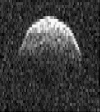
Bennu was discovered on 11 September 1999 during a Near-Earth asteroid survey by the Lincoln Near-Earth Asteroid Research (LINEAR).[3] The asteroid was given the provisional designation 1999 RQ36 and classified a near-Earth asteroid. Bennu approached close to Earth and it was observed extensively by the Arecibo Observatory and the Goldstone Deep Space Network using radar imaging as Bennu closely approached Earth on 23 September 1999.[21][13]
Naming
The name Bennu was selected from more than eight thousand student entries from dozens of countries around the world who entered a "Name That Asteroid!" contest run by the University of Arizona, The Planetary Society, and the LINEAR Project in 2012.[1][9] Third-grade student Michael Puzio from North Carolina proposed the name in reference to the Egyptian mythological bird Bennu. To Puzio, the OSIRIS-REx spacecraft with its extended TAGSAM arm resembled the Egyptian deity, which is typically depicted as a heron.[1]
Its features will be named after birds and bird-like creatures in mythology.[22]
Physical characteristics

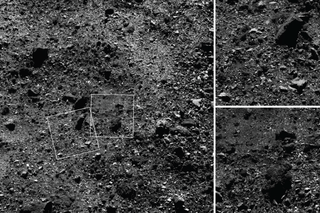
Bennu has a roughly spheroidal shape, resembling a spinning top. Bennu's axis of rotation is tilted 178 degrees to its orbit; the direction of rotation about its axis is retrograde with respect to its orbit.[5] While the initial ground based radar observations indicated that Bennu had a fairly smooth shape with one prominent 10–20 m boulder on its surface,[12] high resolution data obtained by OSIRIS-REx revealed that the surface is much rougher with more than 200 boulders larger than 10 m on the surface, the largest of which is 58 m across.[5]
There is a well-defined ridge along the equator of Bennu. The presence of this ridge suggests that fine-grained regolith particles have accumulated in this area, possibly because of its low gravity and fast rotation.[12] Observations by the OSIRIS-REx spacecraft has shown that Bennu is rotating faster over time.[23] This change in Bennu's rotation is caused by the Yarkovsky–O'Keefe–Radzievskii–Paddack effect, or the YORP effect.[23] Due to the uneven emission of thermal radiation from its surface as Bennu rotates in sunlight, the rotation period of Bennu decreases by about one second every 100 years.[23]
Observations of this minor planet by the Spitzer Space Telescope in 2007 gave an effective diameter of 484±10 m, which is in line with other studies. It has a low visible geometric albedo of 0.046±0.005. The thermal inertia was measured and found to vary by approximately 19% during each rotational period. The data suggest that the regolith grain size is moderate, ranging from several millimeters up to a centimeter, and evenly distributed. No emission from a potential dust coma has been detected around Bennu, which puts a limit of 106 g of dust within a radius of 4750 km.[24]
Astrometric observations between 1999 and 2013 have demonstrated that 101955 Bennu is influenced by the Yarkovsky effect, causing the semimajor axis to drift on average by 284±1.5 meters/year. Analysis of the gravitational and thermal effects has given a bulk density of ρ = 1190±13 kg/m3, which is only slightly denser than water. Therefore, the predicted macroporosity is 40±10%, suggesting the interior has a rubble pile structure. The estimated mass is (7.329±0.009)×1010 kg.[5]
Photometry and spectroscopy
Photometric observations of Bennu in 2005 yielded a synodic rotation period of 4.2905±0.0065 h. It has a B-type classification, which is a sub-category of carbonaceous asteroids. Polarimetric observations show that Bennu belongs to the rare F subclass of carbonaceous asteroids, which is usually associated with cometary features.[8] Measurements over a range of phase angles showed a phase function slope of 0.040 magnitudes per degree, which is similar to other near-Earth asteroids with low albedo.[25]
Before OSIRIS-REx, spectroscopy indicated a correspondence with the CI and/or CM carbonaceous chondrite meteorites,[26][27][28] including carbonaceous-chondrite mineral magnetite.[29][30][31] Magnetite, a spectrally prominent[32][33] water product[34][35][36] but destroyed by heat,[36] is an important proxy of astronomers[37][38][39] including OSIRIS-REx staff.[40]
Preliminary spectroscopic surveys of the asteroid's surface by OSIRIS-REx then confirmed magnetite and the meteorite-asteroid linkage,[41][42][43] dominated by phyllosilicates.[44][45][46] Phyllosilicates, among others, hold water.[47][48][49]
Bennu's water spectra were detectable on approach,[42][50] reviewed by outside scientists,[51][32] then confirmed from orbit.[29][52] This is defined as water, by geologists[53][54] astrogeologists[55] (lunar[56][57] and Martian[53][58] [59]), geochemists,[60][61] meteoriticists,[62][63] and astronomers,[64][65][66] as such specimens generate water under, e. g., the space environment[67][68] or via mining.[69]
Activity
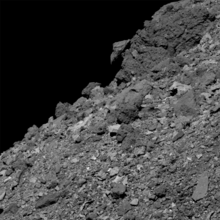
Bennu is an active asteroid,[70][71][72][73] sporadically emitting plumes of particles[74][75] and rocks as large as 10 cm (3.9 in),[76][77] (not dust, defined as tens of micrometers).[78][79] Scientists hypothesize the releases may be caused by thermal fracturing, volatile release through dehydration of phyllosilicates, and/or meteoroid impacts.[77]
Before the arrival of OSIRIS-REx, Bennu had displayed polarization consistent with Comet Hale-Bopp and 3200 Phaethon, a rock comet.[8] Bennu, Phaethon, and inactive Manx comets[80] are examples of active asteroids.[81][82][72] B-type asteroids displaying a blue color in particular, may be dormant comets.[83][84][85] If the IAU declares Bennu to be a dual-status object, its comet designation would be P/1999 RQ36 (LINEAR).[86]

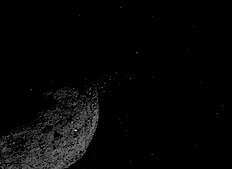
Surface features
All geological features on Bennu are named after various species of birds and bird-like figures in mythology.[88] The first features to be named were the final four candidate OSIRIS-REx sample sites, which were given unofficial names by the team in August 2019.[89] On March 6, 2020 the IAU announced the first official names for 12 Bennu surface features, including regiones (broad geographic regions), craters, dorsa (ridges), fossae (grooves or trenches) and saxa (rocks and boulders).[90]
Candidate sample sites

| Name | Location | Description |
|---|---|---|
| Nightingale | 56°N 43°E | Abundant fine-grained material with a large variation in color. Primary sample collection site.[92] |
| Kingfisher | 11°N 56°E | A relatively new crater with the highest water signature of all four sites. |
| Osprey | 11°N 80°E | Located on a low albedo patch with a large variety of rocks. Backup sample collection site.[92] |
| Sandpiper | 47°S 322°E | Located between two young craters, located in rough terrain. Minerals vary in brightness with hints of hydrated minerals. |
On December 12, 2019, after a year of mapping Bennu's surface, a target site was announced. Named Nightingale, the area is near Bennu's north pole and lies inside a small crater within a larger crater. Osprey was selected as the backup sample site.[92]
IAU named features
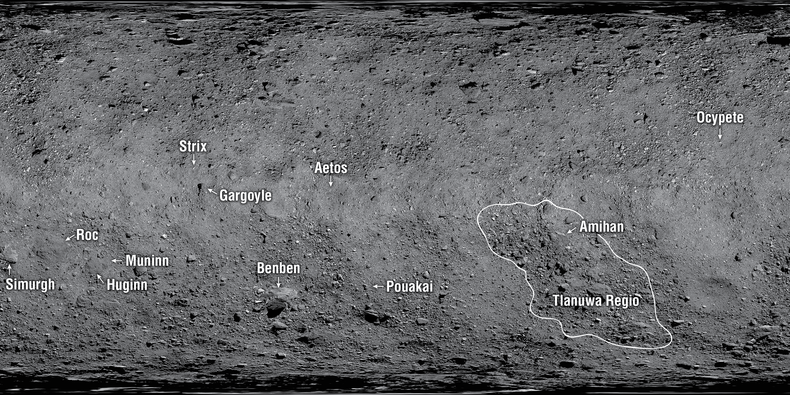
| Name | Named after | Location |
|---|---|---|
| Aellopus Saxum | Aello, one of the half-bird half-woman Harpy sisters from Greek mythology | 25.44°N 335.67°E |
| Aetos Saxum | Aetos, childhood playmate of the god Zeus who was turned into an eagle from Greek mythology | 3.46°N 150.36°E |
| Amihan Saxum | Amihan, bird deity from Philippine mythology | 17.96°S 256.51°E |
| Benben Saxum | Benben, Ancient Egyptian primordial mound that arose from the primordial waters Nu | 45.86°S 127.59°E |
| Boobrie Saxum | Boobrie, shapeshifting entity from Scottish mythology that often takes the form of a giant water bird | 48.08°N 214.28°E |
| Camulatz Saxum | Camulatz, one of four birds in the K'iche' creation myth in Maya mythology | 10.26°S 259.65°E |
| Celaeno Saxum | Celaeno, one of the half-bird half-woman Harpy sisters from Greek mythology | 18.42°N 335.23°E |
| Ciinkwia Saxum | Ciinkwia, thunder beings from Algonquian mythology that look like giant eagles | 4.97°S 249.47°E |
| Dodo Saxum | Dodo, a dodo bird character from Alice's Adventures in Wonderland | 32.68°S 64.42°E |
| Gamayun Saxum | Gamajun, prophetic bird from Slavic mythology | 9.86°N 105.45°E |
| Gargoyle Saxum | Gargoyle, dragon-like monster with wings | 4.59°N 92.48°E |
| Gullinkambi Saxum | Gullinkambi, rooster from Norse mythology that lives in Valhalla | 18.53°N 17.96°E |
| Huginn Saxum | Huginn, one of two ravens that accompany the god Odin in Norse mythology | 29.77°S 43.25°E |
| Kongamato Saxum | Kongamato, giant flying creature from Kaonde mythology | 5.03°N 66.31°E |
| Muninn Saxum | Muninn, one of two ravens that accompany the god Odin in Norse mythology | 29.34°S 48.68°E |
| Ocypete Saxum | Ocypete, one of the half-bird half-woman Harpy sisters from Greek mythology | 25.09°N 328.25°E |
| Odette Saxum | Odette, princess that turns into the White Swan in Swan Lake | 44.86°S 291.08°E |
| Odile Saxum | Odile, the Black Swan from Swan Lake | 42.74°S 294.08°E |
| Pouakai Saxum | Poukai, monstrous bird from Māori mythology | 40.45°S 166.75°E |
| Roc Saxum | Roc, giant bird of prey from Arabic mythology | 23.46°S 25.36°E |
| Simurgh Saxum | Simurgh, benevolent bird that possesses all knowledge from Iranian mythology | 25.32°S 4.05°E |
| Strix Saxum | Strix, bird of ill omen from Roman mythology | 13.4°N 88.26°E |
| Thorondor Saxum | Thorondor, the King of the Eagles in Tolkien's Middle-earth | 47.94°S 45.1°E |
| Tlanuwa Regio | Tlanuwa, giant birds from Cherokee mythology | 37.86°S 261.7°E |
Origin and evolution
The carbonaceous material that composes Bennu originally came from the breakup of a much larger parent body—a planetoid or a proto-planet. But like nearly all other matter in the Solar System, the origins of its minerals and atoms are to be found in dying stars such as red giants and supernovae.[94] According to the accretion theory, this material came together 4.5 billion years ago during the formation of the Solar System.
Bennu's basic mineralogy and chemical nature would have been established during the first 10 million years of the Solar System's formation, where the carbonaceous material underwent some geologic heating and chemical transformation inside a much larger planetoid or a proto-planet capable of producing the requisite pressure, heat and hydration (if need be)—into more complex minerals.[12] Bennu probably began in the inner asteroid belt as a fragment from a larger body with a diameter of 100 km. Simulations suggest a 70% chance it came from the Polana family and a 30% chance it derived from the Eulalia family.[95]
Subsequently, the orbit drifted as a result of the Yarkovsky effect and mean motion resonances with the giant planets, such as Jupiter and Saturn. Various interactions with the planets in combination with the Yarkovsky effect modified the asteroid, possibly changing its spin, shape, and surface features.[96]
Cellino et al. have suggested a possible cometary origin for Bennu, based on similarities of its spectroscopic properties with known comets. The estimated fraction of comets in the population of near Earth objects is 8%±5%.[8] This includes rock comet 3200 Phaethon, originally discovered as, and still numbered as an asteroid.[97][98]
Orbit
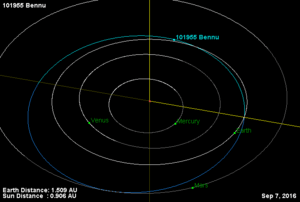
Possible Earth impact
On average, an asteroid with a diameter of 500 m (1,600 ft; 0.31 mi) can be expected to impact Earth about every 130,000 years or so.[99] A 2010 dynamical study by Andrea Milani and collaborators predicted a series of eight potential Earth impacts by Bennu between 2169 and 2199. The cumulative probability of impact is dependent on physical properties of Bennu that were poorly known at the time, but was found to not exceed 0.071% for all eight encounters.[100] The authors recognized that an accurate assessment of 101955 Bennu's probability of Earth impact would require a detailed shape model and additional observations (either from the ground or from spacecraft visiting the object) to determine the magnitude and direction of the Yarkovsky effect.
The publication of the shape model and of astrometry based on radar observations obtained in 1999, 2005, and 2011,[21] made possible an improved estimate of the Yarkovsky acceleration and a revised assessment of the impact probability. The current (as of 2014) best estimate of the impact probability is a cumulative probability of 0.037% in the interval 2175 to 2196.[101] This corresponds to a cumulative score on the Palermo scale of −1.71. If an impact were to occur, the expected kinetic energy associated with the collision would be 1,200 megatons in TNT equivalent (for comparison, TNT equivalent of Little Boy was approx 15 kiloton).[11]
2060 close approach
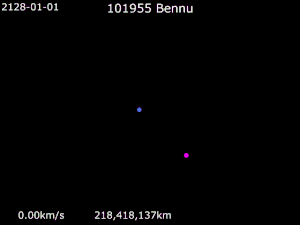
Earth · 101955 Bennu
Bennu will pass 0.005 au (750,000 km; 460,000 mi) from Earth on 23 September 2060,[1] while Moon's average orbital distance (Lunar Distance, LD) is 384,402 km (238,856 mi) today and 384,404 km in 50 years time. It will be too dim to be seen with common binoculars.[102] The close approach of 2060 causes divergence in the close approach of 2135. On 25 September 2135, the nominal approach distance is 0.002 au (300,000 km; 190,000 mi) from Earth, but Bennu could pass as close as 0.0007 au (100,000 km; 65,000 mi).[1] There is no chance of an Earth impact in 2135.[103][11] The 2135 approach will create many lines of variations and Bennu may pass through a gravitational keyhole during the 2135 passage which could create an impact scenario at a future encounter. The keyholes are all less than 55 km wide.[101]
On 25 September 2175, there is a 1 in 24,000 chance of an Earth impact,[11] but the nominal 2175 approach is in February 2175 at a distance of roughly 0.1 au (15,000,000 km; 9,300,000 mi).[1] The most threatening virtual impactor is on 24 September 2196 when there is a 1 in 11,000 chance of an Earth impact.[11] There is a cumulative 1 in 2,700 chance of an Earth impact between 2175–2199.[11]
Long term
Lauretta et al. reported in 2015 their results of a computer simulation, concluding that it is more likely that 101955 Bennu will be destroyed by some other cause:
The orbit of Bennu is intrinsically dynamically unstable, as are those of all NEOs. In order to glean probabilistic insights into the future evolution and likely fate of Bennu beyond a few hundred years, we tracked 1,000 virtual "Bennus" for an interval of 300 Myr with the gravitational perturbations of the planets Mercury–Neptune included. Our results ... indicate that Bennu has a 48% chance of falling into the Sun. There is a 10% probability that Bennu will be ejected out of the inner Solar System, most likely after a close encounter with Jupiter. The highest impact probability for a planet is with Venus (26%), followed by the Earth (10%) and Mercury (3%). The odds of Bennu striking Mars are only 0.8% and there is a 0.2% chance that Bennu will eventually collide with Jupiter.[96]
| Asteroid | Date | Nominal approach distance (LD) | Min. distance (LD) | Max. distance (LD) | Absolute magnitude (H) | Size (meters) |
|---|---|---|---|---|---|---|
| (152680) 1998 KJ9 | 1914-12-31 | 0.606 | 0.604 | 0.608 | 19.4 | 279–900 |
| (458732) 2011 MD5 | 1918-09-17 | 0.911 | 0.909 | 0.913 | 17.9 | 556–1795 |
| (163132) 2002 CU11 | 1925-08-30 | 0.903 | 0.901 | 0.905 | 18.5 | 443–477 |
| 2017 VW13 | 2001-11-08 | 0.454 | 0.318 | 3.436 | 20.7 | 153–494 |
| (153814) 2001 WN5 | 2028-06-26 | 0.647 | 0.647 | 0.647 | 18.2 | 921–943 |
| 99942 Apophis | 2029-04-13 | 0.0981 (GEO is 0.109) | 0.0963 | 0.1000 | 19.7 | 310–340 |
| 2005 WY55 | 2065-05-28 | 0.865 | 0.856 | 0.874 | 20.7 | 153–494 |
| 101955 Bennu | 2135-09-25 | 0.780 | 0.308 | 1.406 | 20.19 | 472–512 |
| (153201) 2000 WO107 | 2140-12-01 | 0.634 | 0.631 | 0.637 | 19.3 | 427–593 |
Meteor shower
As an active asteroid with a small Earth-MOID, Bennu may be the parent body of a weak meteor shower. Bennu particles would radiate around September 25 from the southern constellation of Sculptor.[104] The meteors are expected to be near the naked eye limit and only produce a Zenith hourly rate of less than 1.[104]
OSIRIS-REx


OSIRIS-REx; 101955 Bennu; Earth; Sun;

OSIRIS-REx · 101955 Bennu
The OSIRIS-REx mission of NASA's New Frontiers program was launched towards 101955 Bennu on September 8, 2016. On December 3, 2018, the spacecraft arrived at the asteroid Bennu after a two-year journey.[18] One week later, at the American Geophysical Union Fall Meeting, investigators announced that OSIRIS-REx had discovered spectroscopic evidence for hydrated minerals on the surface of the asteroid, implying that liquid water was present in Bennu's parent body before it split off.[105][5] OSIRIS-REx is expected to return samples to Earth in 2023.[106]
Selection
Bennu was selected from over 500000 known asteroids by the OSIRIS-REx selection committee. The primary constraint for selection was close proximity to Earth, since proximity implies low impulse (Δv) required to reach an object from Earth orbit.[107] The criteria stipulated an asteroid in an orbit with low eccentricity, low inclination, and an orbital radius of 0.8–1.6 au.[108] Furthermore, the candidate asteroid for a sample-return mission must have loose regolith on its surface, which implies a diameter greater than 200 meters. Asteroids smaller than this typically spin too fast to retain dust or small particles. Finally, a desire to find an asteroid with pristine carbon material from the early Solar System, possibly including volatile molecules and organic compounds, reduced the list further.
With the above criteria applied, five asteroids remained as candidates for the OSIRIS-REx mission, and Bennu was chosen, in part for its potentially hazardous orbit.[108]
Gallery
 A compilation of radar images of asteroid Bennu (left) and a corresponding 3D shape model. (right)
A compilation of radar images of asteroid Bennu (left) and a corresponding 3D shape model. (right)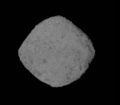 This picture, taken by the OSIRIS-REx spacecraft on November 2, 2018, was part of a sequence of frames collected to show asteroid 101955 Bennu rotating. Bennu is approximately 200 pixels wide in this shot.
This picture, taken by the OSIRIS-REx spacecraft on November 2, 2018, was part of a sequence of frames collected to show asteroid 101955 Bennu rotating. Bennu is approximately 200 pixels wide in this shot. 3D shape model of Bennu made from OSIRIS-REx images.
3D shape model of Bennu made from OSIRIS-REx images.
See also
- List of minor planets and comets visited by spacecraft § Notes
- (341843) 2008 EV5, provisional target of the cancelled Asteroid Redirect Mission
References
- "JPL Small-Body Database Browser: 101955 Bennu (1999 RQ36)" (2017-09-01 last observation. Solution includes non-gravitational parameters). Jet Propulsion Laboratory. Archived from the original on 19 March 2018. Retrieved 20 August 2016.
- "Bennu". Dictionary.com Unabridged. Random House.
- "(101955) Bennu = 1999 RQ36 Orbit". Minor Planet Center. Retrieved 21 March 2018.
- "(101955) Bennu". NEODyS. University of Pisa. Retrieved 1 December 2015.
- Lauretta, D. S. (19 March 2019). "The unexpected surface of asteroid (101955) Bennu". Nature. 568 (7750): 55–60. Bibcode:2019Natur.568...55L. doi:10.1038/s41586-019-1033-6. PMC 6557581. PMID 30890786.
- Barnouin, O. S. (19 March 2019). "Shape of (101955) Bennu indicative of a rubble pile with internal stiffness". Nature Geoscience. 12 (4): 247–252. Bibcode:2019NatGe..12..247B. doi:10.1038/s41561-019-0330-x. PMC 6505705. PMID 31080497.
- "Planetary Habitability Calculators". Planetary Habitability Laboratory. University of Puerto Rico at Arecibo. Retrieved 6 December 2015.
- Hergenrother, Carl W; Maria Antonietta Barucci; Barnouin, Olivier; Bierhaus, Beau; Binzel, Richard P; Bottke, William F; Chesley, Steve; Clark, Ben C; Clark, Beth E; Cloutis, Ed; Christian Drouet d'Aubigny; Delbo, Marco; Emery, Josh; Gaskell, Bob; Howell, Ellen; Keller, Lindsay; Kelley, Michael; Marshall, John; Michel, Patrick; Nolan, Michael; Rizk, Bashar; Scheeres, Dan; Takir, Driss; Vokrouhlický, David D; Beshore, Ed; Lauretta, Dante S (2018). "Unusual polarimetric properties of (101955) Bennu: similarities with F-class asteroids and cometary bodies". Monthly Notices of the Royal Astronomical Society: Letters. 481 (1): L49–L53. arXiv:1808.07812. Bibcode:2018MNRAS.481L..49C. doi:10.1093/mnrasl/sly156.
- Murphy, Diane (1 May 2013). "Nine-Year-Old Names Asteroid Target of NASA Mission in Competition Run By The Planetary Society". The Planetary Society. Retrieved 20 August 2016.
- "Sentry Risk Table". NASA/JPL Near-Earth Object Program Office. Archived from the original on 11 September 2016. Retrieved 20 March 2018. (Use Unconstrained Settings)
- "101955 1999 RQ36: Earth Impact Risk Summary". NASA. Jet Propulsion Laboratory. 25 March 2016. Retrieved 20 March 2018.
- Lauretta, D. S.; Bartels, A. E.; et al. (April 2015). "The OSIRIS-REx target asteroid (101955) Bennu: Constraints on its physical, geological, and dynamical nature from astronomical observations". Meteoritics & Planetary Science. 50 (4): 834–849. Bibcode:2015M&PS...50..834L. CiteSeerX 10.1.1.723.9955. doi:10.1111/maps.12353.
- "Goldstone Delay-Doppler Images of 1999 RQ36". Asteroid Radar Research. Jet Propulsion Laboratory.
- Hudson, R. S.; Ostro, S. J.; Benner, L. A. M. (2000). "Recent Delay-Doppler Radar Asteroid Modeling Results: 1999 RQ36 and Craters on Toutatis". Bulletin of the American Astronomical Society. 32: 1001. Bibcode:2000DPS....32.0710H.
- Corum, Jonathan (8 September 2016). "NASA Launches the Osiris-Rex Spacecraft to Asteroid Bennu". The New York Times. Retrieved 9 September 2016.
- Chang, Kenneth (8 September 2016). "The Osiris-Rex Spacecraft Begins Chasing an Asteroid". The New York Times. Retrieved 9 September 2016.
- Brown, Dwayne; Neal-Jones, Nancy (31 March 2015). "RELEASE 15-056 – NASA's OSIRIS-REx Mission Passes Critical Milestone". NASA. Retrieved 4 April 2015.
- Chang, Kenneth (3 December 2018). "NASA's Osiris-Rex Arrives at Asteroid Bennu After a Two-Year Journey — The spacecraft now begins a close study of the primitive space rock, seeking clues to the early solar system". The New York Times. Retrieved 3 December 2018.
- Plait, Phil (4 December 2018). "Welcome to Bennu!". SYFY WIRE. Retrieved 5 December 2018.
- "NASA captures closest-ever photo of massive asteroid Bennu flying near Earth". Sky News. 18 June 2019.
- Nolan, M. C.; Magri, C.; Howell, E. S.; Benner, L. A. M.; Giorgini, J. D.; Hergenrother, C. W.; Hudson, R. S.; Lauretta, D. S.; Margot, J. L.; Ostro, S. J.; Scheeres, D. J. (2013). "Shape model and surface properties of the OSIRIS-REx target Asteroid (101955) Bennu from radar and lightcurve observations". Icarus. 226 (1): 629–640. Bibcode:2013Icar..226..629N. doi:10.1016/j.icarus.2013.05.028. ISSN 0019-1035.
- Hille, Karl (8 August 2019). "Asteroid's Features To Be Named After Mythical Birds". NASA. Retrieved 10 August 2019.
- Morton, Erin (19 March 2019). "NASA Mission Reveals Asteroid Has Big Surprises". AsteroidMission.org. Retrieved 19 March 2019.
- Emery, J.; et al. (July 2014), Muinonen, K. (ed.), "Thermal infrared observations and thermophysical characterization of the OSIRIS-REx target asteroid (101955) Bennu", Conference Proceedings Asteroids, Comets, Meteors 2014: 148, Bibcode:2014acm..conf..148E.
- Hergenrother, Carl W.; et al. (September 2013), "Lightcurve, Color and Phase Function Photometry of the OSIRIS-REx Target Asteroid (101955) Bennu", Icarus, 226 (1): 663–670, Bibcode:2013Icar..226..663H, doi:10.1016/j.icarus.2013.05.044.
- King, A; Solomon, J; Schofield, P; Russell, S (December 2015). "Characterising the CI and CI-like carbonaceous chondrites using thermogravimetric analysis and infrared spectroscopy". Earth, Planets and Space. 67: 1989. Bibcode:2015EP&S...67..198K. doi:10.1186/s40623-015-0370-4.
- Takir, D; Emery, J; Hibbits, C (2017). 3-μm Spectroscopy Of Water-Rich Meteorites And Asteroids: New Results And Implications. Hayabusa Symposium 2017.
- Bates, H; Hanna, K; King, A; Bowles, N (2018). Thermal Infrared Spectra of Heated CM and C2 Chondrites and Implications for Asteroid Sample Return Missions. Hayabusa Symposium 2018.
- Hamilton, V; Simon, A; Kaplan, H; Christensen, P; Reuter, D; DellaGiustina, D; Haberle, C; Hanna, R; Brucato, J; Praet, A; Glotch, T; Rogers, A; Connolly, H; McCoy, T; Emery, J; Howell, E; Barucci, M; Clark, B; Lauretta, D (March 2020). "OVIRS Results". VNIR and TIR spectral characteristics of (101955) Bennu from OSIRIS-REx Detailed Survey and Reconnaissance Observations. 51st LPSC.
- Mason, B (1962). Meteorites. New York and London: John Wiley and Sons Inc. p. 60.
an important constituent in many of the carbonaceous chondrites
- Takir, D; Emery, J; McSween, H; Hibbits, C; Clark, R; Pearson, N; Wang, A (2013). "Nature and degree of aqueous alteration in CM and CI carbonaceous chondrites". Meteoritics & Planetary Science. 48 (9).
- Bates, H; King, A; Donaldson-Hanna, K; Bowles, N; Russell, S (19 November 2019). "Linking mineralogy and spectroscopy of highly aqueously altered CM and CI carbonaceous chondrites in preparation for primitive asteroid sample return". Meteoritics & Planetary Science. 55 (1). doi:10.1111/maps.13411.
observations of primitive, water‐rich asteroids
- King, A; Schofield, P; Russell, S (2017). "Type 1 aqueous alteration in CM carbonaceous chondrites: Implications for the evolution of water-rich asteroids". Meteoritics & Planetary Science. 52 (6).
small amounts of opaque phases (e.g.,magnetite, Fe-sulfides) known to ...have a large effect on the overall spectral shape
- Kerridge, J; Mackay, A; Boynton, W (27 July 1979). "Magnetite in CI Carbonaceous Meteorites: Origin by Aqueous Activity on a Planetesimal Surface". Science. 205 (4404): 395.
- Brearley, A. "The Action of Water". Meteorites and the Early Solar System II. Tucson: University of Arizona Press. p. 587. ISBN 9780816525621.
- Rubin, A; Li, Y (December 2019). "Formation and destruction of magnetite in CO3 chondrites and other chondrite groups". Geochemistry. 79 (4): article 125528.
- Yang, B; Jewitt, D (2010). "Identification of Magnetite in B-type asteroids". Astronomical Journal. 140: 692.
evidence of water ice" "an important product of parent-body aqueous alteration
- Kita, J; Defouilloy, C; Goodrich, C; Zolensky, M (2017). "O isotope ratios of magnetite in CI-like clasts from a polymict ureilite".
ratios of magnetite are of special interest because...
Cite journal requires|journal=(help) - Cloutis, E; Hiroi, T; Gaffey, M; Alexander, C; Mann, P (2011). "Spectral Reflectance Properties of carbonaceous chondrites: 1. CI chondrites". Icarus. 212: 180.
- Clark, B; Binzel, R; Howell, E; Cloutis, E; Ockert-Bell, M; Christensen, P; Barucci, M; DeMeo, F; Lauretta, D; Connolly, H; Soderberg, A; Hergenrother, C; Lim, L; Emery, J; Mueller, M (2011). "Asteroid (101955) 1999 RQ36: Spectroscopy from 0.4 to 2.4 μm and meteorite analogs". Icarus. 216 (2): 462.
- All About Bennu: A Rubble Pile with a Lot of Surprises. Kimberly M. S. Cartier, EOS Planetary Sciences. 21 March 2019. "In terms of spectra and minerology, Bennu’s rocks 'look a lot like the rarest, most fragile meteorites in our collection,' Lauretta said, referring to the CM carbonaceous chondrites"
- Hamilton, V. E.; Simon, A. A. (2019). "Evidence for widespread hydrated minerals on asteroid (101955) Bennu". Nature Astronomy. 3 (4): 332–340. Bibcode:2019NatAs...3..332H. doi:10.1038/s41550-019-0722-2. hdl:1721.1/124501. PMC 6662227. PMID 31360777.
- Lauretta, D (4 April 2019). "The unexpected surface of asteroid (101955) Bennu". Nature. 568 (7750): 55–60. Bibcode:2019Natur.568...55L. doi:10.1038/s41586-019-1033-6. PMC 6557581. PMID 30890786. "This finding is in agreement with pre-encounter measurements and consistent with CI and CM chondrites."
- "NASA's Newly Arrived OSIRIS-REx Spacecraft Already Discovers Water on Asteroid". NASA. 11 December 2018.
- "Water found on asteroid, confirming Bennu as excellent mission target". Science Daily. 10 December 2018. Retrieved 10 December 2018.
- Lauretta, D. "Welcome to Bennu Press Conference - First Mission Science Results". Retrieved 24 July 2019. "Report Card" at 25:15
- Feierberg, M; Lebofsky, L; Tholen, D (1985). "The nature of C-class asteroids from 3u spectrophotometry". Icarus. 63 (2): 191. Bibcode:1985Icar...63..183F. doi:10.1016/0019-1035(85)90002-8.
- Sears, D (2004). The Origin of Chondrules and Chondrites. Cambridge University Press. ISBN 978-1107402850.
- Russell, Sara S.; Ballentine, Chris J.; Grady, Monica M. (17 April 2017). "The origin, history and role of water in the evolution of the inner Solar System". Philosophical Transactions of the Royal Society A: Mathematical, Physical and Engineering Sciences. 375 (2094): 20170108. Bibcode:2017RSPTA.37570108R. doi:10.1098/rsta.2017.0108. PMC 5394259. PMID 28416731.
Water in chondrites is contained within clay minerals, with H2O accounting for up to 10% weight percent...water is also stored in chondrites in direct liquid form as inclusions
- Kaplan, H; Hamilton, V; Howell, E; Anderson, S; Barrucci, M; Brucato, J; Burbine, T; Clark, B; Cloutis, E; Connolly, H; Dotto, E; Emery, J; Fornasier, S; Lantz, C; Lim, L; Merlin, F; Praet, A; Reuter, D; Sandford, S; Simon, A; Takir, D; Lauretta, D (2020). "Visible-near infrared spectral indices for mapping mineralogy and chemistry with OSIRIS-REx". Meteoritics & Planetary Science. 55 (4): 744-65. doi:10.1111/maps.13461.
- Potin, S; Beck, P; Usui, F; Bonal, L; Vernazza, P; Schmidtt, B (September 2020). "Style and intensity of hydration among C-complex asteroids: A comparison to dessicated carbonaceous chondrites". Icarus. 348: article 113826. doi:10.1016/j.icarus.2020.113826.
- Praet, A; Barucci, M; Kaplan, H; Merlin, F; Clark, B; Simon, A; Hamilton, V; Emery, J; Howell, E; Lim, L (March 2020). Estimated hydration of Bennu's surface from OVIRS observations by the OSIRIS-REx mission. 51st LPSC.
- Carr, M; Wänke, H (1992). "Earth and Mars: Water Inventories as Clues to Accretional Histories". Icarus. 98: 61.
- Ohtani, E (January 2020). "The role of water in Earth's mantle". National Science Review. 7 (1): 224.
- Greenwood, J; Karato, S; Vander Kaaden, K; Pahlevan, K; Usui, T (July 2018). "Water and Volatile Inventories of Mercury, Venus, the Moon, and Mars". Space Science Reviews. 214: article 92.
- Simon, J; Christoffersen, R; Wang, J; Mouser, M; Mills, R; Ross, D; Rahman, Z; Alexander, C (May 2020). "Volatiles in lunar felsite clasts: Impact-related delivery of hydrous material to an ancient dry lunar crust". Geochimica et Cosmochimica Acta. 276: 299.
- Stephant, A; Anand, M; Tartèse, R; Zhao, X; Degli-Alessandrini, G; Franchi, I (June 2020). "The hydrogen isotopic composition of lunar melt inclusions: An interplay of complex magmatic and secondary processes". Geochimica et Cosmochimica Acta. 284: 196.
the term "water" used here collectively refers to all major forms of hydrogen (i.e., H, OH, H2O)" "measurements of water (H, OH, H2O) abundances" ... 5.2 "Our findings are therefore consistent with the present understanding that the water in the Moon has a broadly chondritic origin
- Peslier, A; Hervig, R; Yang, S; Humayun, M; Barnes, J; Irving, A; Brandon, A (December 2019). "Determination of the water content and D/H ratio of the martian mantle by unraveling degassing and crystallization effects in nakhlites". Geochimica et Cosmochimica Acta. 266: 382.
- Jiménez-Díaz, A; Egea-Gonzalez, I; Parro, L; Tasaka M; Ruiz, J (January 2020). "The thermal structure and mechanical behavior of the Martian Lithosphere". Icarus: article 113635.
- Urey, H. (1963). "4 The Origin and Evolution of the Solar System". In Donald Le Galley (ed.). Space Science. John Wiley & Sons. p. 140.
The carbonaceous chondrites contain substantial amounts of carbon and water
- Suess, H. (1987). "4 Members of the solar system". Chemistry of the Solar System: An Elementary Introduction To Cosmochemistry. John Wiley & Sons. pp. 105, 106. ISBN 0-471-83107-7.
- Van Schmus, W; Wood, J (1967). "A chemical-petrologic classification for the chondritic meteorites". Geochimica et Cosmochimica Acta. 31: 747–65.
- Martin, P; Lee, M (March 2020). Degree of Aqueous Alteration of the CM Carbonaceous Chondrite Aguas Zarcas: Implications for Understanding Ryugu and Bennu. 51st LPSC.
These meteorites have a relatively high water content (~ 9 wt%;
- Alexander, C; McKeegan, K; Altwegg, K (February 2018). "Water Reservoirs in Small Planetary Bodies: Meteorites, Asteroids, and Comets". Space Science Reviews. 214: article 1.
- McCubbin, F; Barnes, J (November 2019). "Origin and abundance of H2O in the terrestrial planets, Moon, and asteroids". Earth and Planetary Science Letters. 526: article 115771.
- Venturini, J; Ronco, M; Guilera, O (July 2020). "Setting the Stage: Planet Formation and Volatile Delivery". Space Science Reviews. 216: article 86.
- Zhu, C; Góbi, S; Abplanalp, M; Frigge, R; Gillis-Davis, J; Dominguez, G; Miljković, K; Kaiser, R (January 2020). "Regenerative water sources on surfaces of airless bodies". Nature Astronomy. 4: 45-52. doi:10.1038/s41550-019-0900-2.
- "Small in size only". Nature Astronomy. 4: 1. 14 January 2020. doi:10.1038/s41550-019-1006-6.
- Q&A: Water Found on Asteroid. Interview with Professor Beth Ellen Clark, OSIRIS-REx mission scientist. Ithaca College. 13 December 2018. Quote:"Third, the asteroid mining community has set a commercial price point for mining water on asteroids, and if Bennu's water is held in clays and other water-rich minerals on the surface, that would make asteroids like Bennu attractive for mining water."
- Connolly, H; Jawin, E; Ballouz, R; Walsh, K; McCoy, T; Dellagiustina, D (2019). OSIRIS-REx sample science and the geology of active asteroid Bennu. 82nd Meteoritical Society Meeting. p. 2157.
- Lim, L (2019). OSIRIS-REx update. 21st NASA Small Bodies Assessment Group. "Bennu is an Active Asteroid!"
- Barrucci, M; Michel, P (September 2019). Asteroid-Comet continuum: no doubt but many questions. 2019 EPSC-DPS conference. p. 202–1.
- Hergenrother, C; Adam, C; Antreasian, P; Al Asad, M; Balram-Knutson, S (September 2019). (101955) Bennu is an active asteroid. 2019 EPSC-DPS conference. p. 852–1.
- "Feb 11, 2019". Retrieved 15 November 2019.
- Hergenrother, C; Maleszweski, C; Nolan, C; Li, J; Drouet D'aubigny, C (19 March 2019). "The Operational Environment and Rotational Acceleration of Asteroid (101955) Bennu from OSIRIS-REx Observations". Nature Communications. 10 (1): 1291. Bibcode:2019NatCo..10.1291H. doi:10.1038/s41467-019-09213-x. PMC 6425024. PMID 30890725.
- No One Knows Why Rocks Are Exploding From Asteroid Bennu. Daniel Oberhaus, Wired. 5 December 2019.
- Lauretta, D. S.; Hergenrother, C. W.; Chesley, S. R.; Leonard, J. M.; Pelgrift, J. Y.; et al. (6 December 2019). "Episodes of particle ejection from the surface of the active asteroid (101955) Bennu". Science. 366 (6470): eaay3544. doi:10.1126/science.aay3544. PMID 31806784..
- [www.iau.org/static/science/scientific_bodies/commissions/f1/meteordefinitions_approved.pdf "Definitions of terms in meteor astronomy"] Check
|url=value (help) (PDF). Retrieved 31 July 2020. - Grun, E; Krüger, H; Srama, R (2019). "The Dawn of Dust Astronomy". Space Science Reviews. 215: article 46.
|section=ignored (help) - Boe, B; Jedicke, R; Wiegert, P; Meech, K; Morbidelli, A (September 2019). Distinguishing Between Solar System Formation Models with Manxes (or not). 2019 EPSC-DPS conference. p. 626–2.
- Gounelle, M (2012). The Asteroid-Comet Continuum: Evidence from Extraterrestrial Samples. 2012 European Planetary Science Congress. p. 220.
- Rickman, H (2018). Origin and Evolution of Comets: Ten Years after the Nice Model, One Year after Rosetta. Singapore: World Scientific. pp. 162–68. Sec. 4.3 Dormancy and Rejuvenation
- Nuth, J; Johnson, N; Abreu, N (March 2019). Are B-type Asteroids Dormant Comets? (PDF). 50th LPSC. p. 2132.
- Schroder, S; Poch, I; Ferrari, M; De Angelis, S; Sultana, R (September 2019), "Experimental evidence for the nature of Ceres blue material" (PDF), Epsc-DPS Joint Meeting 2019, 2019: EPSC–DPS2019–78, Bibcode:2019EPSC...13...78S
- Marsset, M; DeMeo, F; Polishook, D; Binzel, R (September 2019), Near-infrared spectral variability on the newly active asteroid (6478) Gault, p. 280–1
- Bauer, G (2019). Active Asteroids (PDF). 21st NASA Small Bodies Assessment Group.
- Chang, Kenneth; Stirone, Shannon (19 March 2019). "The Asteroid Was Shooting Rocks Into Space. 'Were We Safe in Orbit?' - NASA's Osiris-Rex and Japan's Hayabusa2 spacecraft reached the space rocks they are surveying last year, and scientists from both teams announced early findings on Tuesday (03/19/2019)". The New York Times. Retrieved 21 March 2019.
- "Asteroid's Features to be Named After Mythical Birds". 8 August 2019.
- "OSIRIS-REx Team Picks 4 Candidate Sample Sites on Asteroid Bennu".
- "First Official Names Given to Features on Asteroid Bennu". AsteroidMission.org. NASA. 6 March 2020. Retrieved 6 May 2020.
- "CANDIDATE SAMPLE SITES". AsteroidMission.org. NASA. Retrieved 2 January 2019.
- "X Marks the Spot: Sample Site Nightingale Targeted for Touchdown" (Press release). AsteroidMission.org. NASA. 12 December 2019. Retrieved 28 December 2019.
- "Bennu". Gazetteer of Planetary Nomenclature. International Astronomical Union. Archived from the original on 7 May 2020. Retrieved 6 May 2020.
- Bensby, T.; Feltzing, S. (2006). "The origin and chemical evolution of carbon in the Galactic thin and thick discs" (PDF). Monthly Notices of the Royal Astronomical Society. 367 (3): 1181–1193. arXiv:astro-ph/0601130. Bibcode:2006MNRAS.367.1181B. doi:10.1111/j.1365-2966.2006.10037.x.
- Bottke, William F.; et al. (February 2015), "In search of the source of asteroid (101955) Bennu: Applications of the stochastic YORP model", Icarus, 247: 191–217, Bibcode:2015Icar..247..191B, doi:10.1016/j.icarus.2014.09.046.
- Lauretta, D. S.; et al. (April 2015), "The OSIRIS-REx target asteroid (101955) Bennu: Constraints on its physical, geological, and dynamical nature from astronomical observations", Meteoritics & Planetary Science, 50 (4): 834–849, Bibcode:2015M&PS...50..834L, CiteSeerX 10.1.1.723.9955, doi:10.1111/maps.12353.
- Hergenrother, C (12 December 2013). "The Strange Life of Asteroid Phaethon – Source of the Geminid Meteors". Dslauretta: Life on the Asteroid Frontier. Retrieved 25 July 2019.
- Maltagliati, L (24 September 2018). "Cometary Bennu?". Nature Astronomy. 2 (10): 761. Bibcode:2018NatAs...2..761M. doi:10.1038/s41550-018-0599-5.
- Robert Marcus; H. Jay Melosh & Gareth Collins (2010). "Earth Impact Effects Program". Imperial College London / Purdue University. Retrieved 7 February 2013. (solution using density of 2,600 kg/m^3, sped of 17km/s, and impact angle of 45 degrees)
- Milani, Andrea; Chesley, Steven R.; Sansaturio, Maria Eugenia; Bernardi, Fabrizio; Valsecchi, Giovanni B.; Arratia, Oscar (2009). "Long term impact risk for (101955) 1999 RQ36". Icarus. 203 (2): 460–471. arXiv:0901.3631. Bibcode:2009Icar..203..460M. doi:10.1016/j.icarus.2009.05.029.
- Chesley, Steven R.; Farnocchia, Davide; Nolan, Michael C.; Vokrouhlický, David; Chodas, Paul W.; Milani, Andrea; Spoto, Federica; Rozitis, Benjamin; Benner, Lance A.M.; Bottke, William F.; Busch, Michael W.; Emery, Joshua P.; Howell, Ellen S.; Lauretta, Dante S.; Margot, Jean-Luc; Taylor, Patrick A. (2014). "Orbit and bulk density of the OSIRIS-REx target Asteroid (101955) Bennu". Icarus. 235: 5–22. arXiv:1402.5573. Bibcode:2014Icar..235....5C. doi:10.1016/j.icarus.2014.02.020. ISSN 0019-1035.
- "(101955) Bennu Ephemerides for September 2060". NEODyS (Near Earth Objects – Dynamic Site). Retrieved 15 May 2019.
- Paul Chodas (24 March 2018). "Recent Bennu Press Stories Need Correction". Center for NEO Studies (CNEOS).
- Ye, Quanzhi (2019). "Prediction of Meteor Activities from (101955) Bennu". American Astronomical Society. 3 (3): 56. Bibcode:2019RNAAS...3...56Y. doi:10.3847/2515-5172/ab12e7.
- Wall, Mike (10 December 2018). "Asteroid Bennu Had Water! NASA Probe Makes Tantalizing Find". Space.com. Retrieved 6 January 2019.
- "NASA to Launch New Science Mission to Asteroid in 2016". NASA. 25 May 2011. Retrieved 21 May 2013.
- Near-Earth Asteroid Delta-V for Space Rendezvous
- "Why Bennu?". OSIRIS-REx Mission. Arizona Board of Regents. Retrieved 10 September 2016.
External links
- Video (01:12) – Asteroid Bennu ejecting material into space (CNN; 5 December 2019)
- Video (01:32) – OSIRIS REx's approach to asteroid Bennu (NASA; 7 January 2019)
- Earth Impact Risk Summary: 101955 1999 RQ36 (Years: 2175–2199) – Jet Propulsion Laboratory near-Earth object site
- NEODyS-2 Ephemerides for 2135 (step size: 10 days)
- Delbo, Marco; Michel, Patrick (2011). "Temperature History and Dynamical Evolution of (101955) 1999 Rq 36: A Potential Target for Sample Return from a Primitive Asteroid". The Astrophysical Journal. 728 (2): L42. Bibcode:2011ApJ...728L..42D. doi:10.1088/2041-8205/728/2/L42.
- Hergenrother, Carl W.; et al. (2012). "Physical Properties of OSIRIS-REx Target Asteroid (101955) 1999 RQ36 derived from Herschel, ESO-VISIR and Spitzer observations". Astronomy & Astrophysics. 548: A36. arXiv:1210.5370. Bibcode:2012A&A...548A..36M. doi:10.1051/0004-6361/201220066.
- Hergenrother, Carl W.; et al. (2014). "The Design Reference Asteroid for the OSIRIS-REx Mission Target (101955) Bennu". arXiv:1409.4704 [astro-ph.EP].
- 101955 Bennu at NeoDyS-2, Near Earth Objects—Dynamic Site
- Ephemeris · Obs prediction · Orbital info · MOID · Proper elements · Obs info · Close · Physical info · NEOCC
- 101955 Bennu at the JPL Small-Body Database





